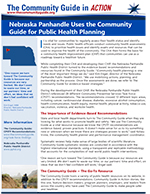Nebraska Panhandle Uses the Community Guide for Public Health Planning
Summary
 While completing their community health assessments and developing a community health improvement plan, the Nebraska Panhandle Public Health District turned to The Community Guide. They referenced 28 different evidence-based Community Preventive Services Task Force (CPSTF) recommendations across 13 topic areas. The Nebraska Panhandle Public Health District also used Healthy People 2020 to set goals and objectives for improvement, matching them with CPSTF recommendations. (Released 2019)
While completing their community health assessments and developing a community health improvement plan, the Nebraska Panhandle Public Health District turned to The Community Guide. They referenced 28 different evidence-based Community Preventive Services Task Force (CPSTF) recommendations across 13 topic areas. The Nebraska Panhandle Public Health District also used Healthy People 2020 to set goals and objectives for improvement, matching them with CPSTF recommendations. (Released 2019)Lessons Learned
- Simplified resources save time and energy. Community Guide products save valuable time and energy while also providing relevant information in a digestible way.
- Evidence is everything. With evidence-based systematic reviews, the science speaks for itself. Having the facts from a reliable source instills confidence when selecting and implementing interventions.
- Achievable goals and objectives lead to success. Healthy People 2020’s goal-setting system helps programs set realistic goals and provides useful evidence-based resources, including CPSTF recommendations. Tracking these successes and making them available to the public can provide both transparency and legitimacy.
Story
While completing their CHA and developing their CHIP, the Nebraska Panhandle Public Health District turned to the evidence-based recommendations and resources found in The Community Guide. “[Community health planning] is one of the most important things we do,” said Kim Engel, director of the Nebraska Panhandle Public Health District. “We use mobilizing actions, planning, and partnership as the process. Once the assessments are done, we refer to The Community Guide for evidence-based strategies.”
During the development of their CHIP, the Nebraska Panhandle Public Health District referenced 28 different Community Preventive Services Task Force (CPSTF) recommendations. The recommendations crossed 13 different topic areas, including cancer, cardiovascular disease, diabetes, excessive alcohol consumption, health communication, health equity, mental health, oral health, physical activity, tobacco use, vaccination, violence, and worksite health.
The Importance of Evidence-Based Recommendations
State and local health departments turn to The Community Guide when they are looking for what works to promote health and safety. “We use The Community Guide as a vital resource because we know the CPSTF recommendations are evidence-based, proven practices. It doesn’t make sense for us to try something new or unknown when we know there are strategies proven to work,” said Kelsey Irvine, the community health planner and performance management coordinator.
Systematic reviews help make sense of large bodies of scientific literature. Community Guide systematic reviews are conducted in accordance with the highest international standards, using a transparent and replicable methodology that accounts for the complexities of real-world public health interventions.
“One reason we turn toward The Community Guide is because our resources are very limited. We don’t want to waste our time, or our partners’ time and effort, on ideas that we don’t feel confident will work,” Engel said.
The Community Guide = The Go-To Resource
The Community Guide hosts a variety of public health resources on its website, in addition to the CPSTF recommendations. Community Guide in Action stories, like this one, feature decision makers, program planners, employers, and leaders from across the country who have used The Community Guide to make people safer and healthier.
Community Guide one-pagers are among the most popular resources available. Designed as easy-to-read handouts, each one summarizes the systematic review evidence and CPSTF finding for a specific intervention approach.
“One of the great things about The Community Guide is that most of the strategies have one-pagers that we can print out and show to our partners. It has information about the intervention approach and the recommendation, and it’s more easily digestible. They’re very easy-to-share handouts that people can just look at and understand. They’re especially helpful when choosing strategies,” Irvine said.
When people use The Community Guide, they know they’re getting evidence-based, peer-reviewed science. “What gets us excited is working with partners toward improved health and knowing that we are using evidence-based strategies. We’re not just guessing,” Engel said. The website also provides links to implementation resources that are designed to help communities conduct a needs assessment; identify and select an intervention approach; and develop, adapt, implement, and evaluate interventions.
Looking Toward a Healthy 2020
As a part of their CHIP, the Nebraska Panhandle Public Health District used Healthy People 2020 to set goals and objectives for improvement, matching them with CPSTF recommendations highlighted on the website. Healthy People 2020, developed by the U.S. Department of Health and Human Services, Office of Disease Prevention and Health Promotion, provides science-based, 10-year national objectives for improving the health of all Americans.
Public health officials in the panhandle are using state vital records and tracking systems developed by partners to measure their progress on CHIP objectives. This information is featured on their website and available to individuals and organizations interested in tracking the program’s progress, including community leaders and decision and policy makers.